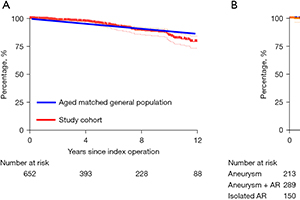Three decades of reimplantation of the aortic valve—the Brussels experience
Abstract
Background: Over the last three decades, the importance of native valve preservation has increasingly become evident. Valve-sparing root replacement procedures, such as the reimplantation or remodeling technique, are therefore being progressively used for aortic root replacement and/or aortic valve repair. Herein, we are summarizing our single-center experience with the reimplantation technique.
Methods: We queried our prospective database for aortic valve repair and recruited all adult (≥18 years) patients who have undergone valve-sparing root replacement with the reimplantation technique between March 1998 and January 2022. We subcategorized the patients into three distinct groups: root aneurysm without aortic regurgitation (AR) (grade ≤1+), root aneurysm with AR (grade >1+) and isolated chronic AR (root <45 mm). Univariable logistic regression analysis was performed to identify variables of interest, which were further analyzed by multivariable Cox-regression analysis. Survival, freedom from valve reintervention, and freedom from recurrent regurgitation, were analyzed with the Kaplan-Meier method.
Results: A total of 652 patients were recruited for this study; 213 patients underwent reimplantation for aortic aneurysm without AR, 289 patients for aortic aneurysm with AR, and 150 patients with isolated AR. Cumulative survival was 95.4% (95% CI: 92.9–97.0%) after 5 years, 84.8% (80.0–88.5%) after 10 years, and 79.5% (73.3–84.5%) after 12 years, which was comparable to the age-matched Belgian population. Older age (HR 1.06, P≤0.001) and male gender (HR 2.1, P=0.02) were associated with late mortality. Freedom from reoperation on the aortic valve at 5 years was 96.2% (95% CI: 93.8–97.7%), and 90.4% (95% CI: 87.4–94.2%) at 12 years. Age (P=0.001) and preoperative left ventricular end-diastolic dimension (LVEDD) (P=0.03) were associated with late reoperation.
Conclusions: Our long-term data supports our reimplantation approach as a viable option for aortic root aneurysms and/or aortic regurgitation, with long-term survival that mirrors that of the general population.
Cover






